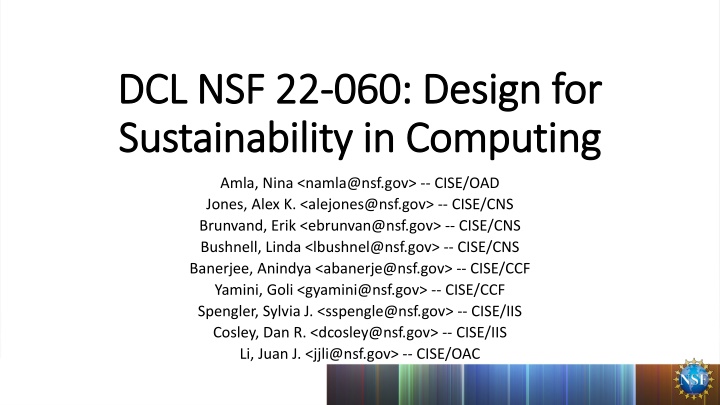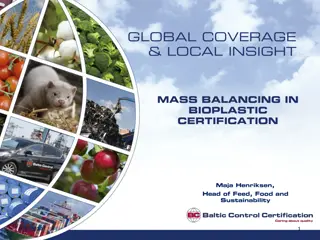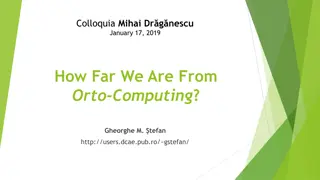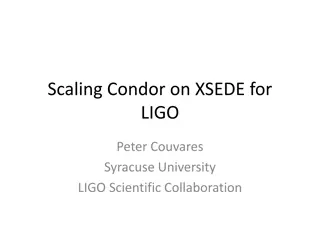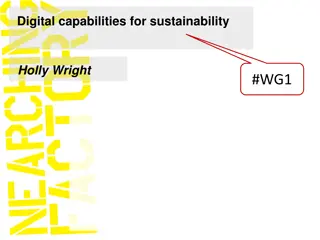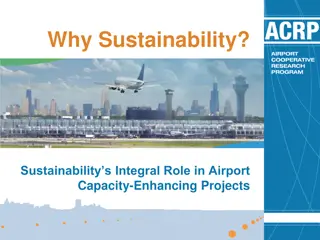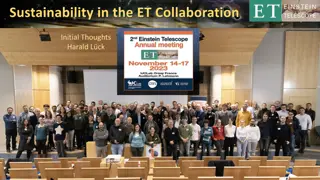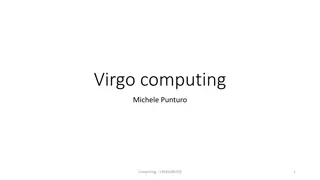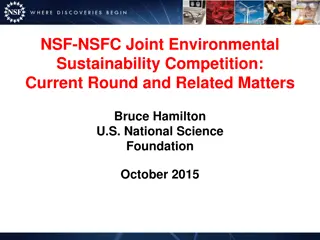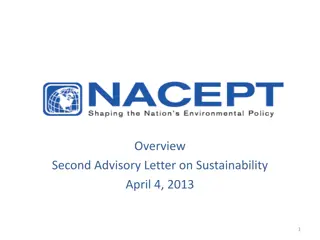Design for Sustainability in Computing
Embodied carbon, environmental impacts, and best practices in sustainable computing. Encouraging novel proposals for disruptive research across computing layers.
Download Presentation

Please find below an Image/Link to download the presentation.
The content on the website is provided AS IS for your information and personal use only. It may not be sold, licensed, or shared on other websites without obtaining consent from the author.If you encounter any issues during the download, it is possible that the publisher has removed the file from their server.
You are allowed to download the files provided on this website for personal or commercial use, subject to the condition that they are used lawfully. All files are the property of their respective owners.
The content on the website is provided AS IS for your information and personal use only. It may not be sold, licensed, or shared on other websites without obtaining consent from the author.
E N D
Presentation Transcript
DCL NSF 22 DCL NSF 22- -060: Design for 060: Design for Sustainability in Computing Sustainability in Computing Amla, Nina <namla@nsf.gov> -- CISE/OAD Jones, Alex K. <alejones@nsf.gov> -- CISE/CNS Brunvand, Erik <ebrunvan@nsf.gov> -- CISE/CNS Bushnell, Linda <lbushnel@nsf.gov> -- CISE/CNS Banerjee, Anindya <abanerje@nsf.gov> -- CISE/CCF Yamini, Goli <gyamini@nsf.gov> -- CISE/CCF Spengler, Sylvia J. <sspengle@nsf.gov> -- CISE/IIS Cosley, Dan R. <dcosley@nsf.gov> -- CISE/IIS Li, Juan J. <jjli@nsf.gov> -- CISE/OAC
Motivation Motivation Embodied carbon is the carbon dioxide (CO ) emissions associated with materials and manufacturing processes. Embodied carbon can account for half of the carbon footprint of datacenter class servers R. Bennis, Life Cycle Assessment of Dell PowerEdge R740, June 2019, https://corporate.delltechnologies.com/content/dam/digitalassets/active/en/una uth/data-sheets/products/servers/lca_poweredge_r740.pdf Embodied carbon can reach 4X the carbon operational footprint of tablets and mobile phones, and 10X of for energy efficient desktops E. Brunvand, D. Kline, and A. K. Jones, Dark Silicon Considered Harmful: A Case for Truly Green Computing, IEEE IGSC, 2018.
NEW DCL on Design for Sustainability in Computing Environmental impacts of computing technologies extend well beyond operational energy consumption E.g. embodied impacts, greenhouse gas emissions, depletion of rare earth materials, e-waste Problem is exacerbated by proliferation, planned obsolescence, compute intensive applications (AI, blockchain), big data, NextG Need fundamentally new & disruptive research in design for sustainability in computing in every layer, and cross-layers, of the computing stack Multiple dimensions (emissions, pollution, renewable versus limited resource usage, embodied costs, supply chain impacts) Full computing spectrum (from HPC to mobile) Full lifecycle (design, manufacturing, operation, & disposal) This DCL encourages the submission of novel and high impact proposals to CISE Core programs (NSF 21-616) https://www.nsf.gov/pubs/2021/nsf21616/nsf21616.htm
Best Practices Best Practices Attend webinars/townhalls/office-hours of the solicitation if available. Send questions to DSC-DCL@nsf.gov. (Note: NSF 21-616 Small-CCF/CNS/IIS has no submission deadline) Read the solicitation closely. Ensure submission complies with submission rules. There are also many useful examples of topic areas of interest. Contact NSF program director with a one-page summary before submission. During the webinar Type in questions at Q&A
Measurement Aspects of Sustainability In Measurement Aspects of Sustainability In Computing Computing New models and metrics for sustainability that are broader than energy efficiency Methods to discover and obtain pareto optimal points for tensions between addressing sustainability and other considerations like performance, correctness, security, privacy, usability, and human and economic cost.
Technology Aspects of Sustainability In Technology Aspects of Sustainability In Computing Computing Techniques for responsible advancements of data organization, storage, precision, analysis, movement, and judicious use of resource intensive techniques (e.g., machine learning, blockchain, and encryption) Meet sustainability metrics while advancing compute capabilities.
Design Aspects of Sustainability In Computing Design Aspects of Sustainability In Computing Design for reusability principles across some or all levels of the entire computing stack to avoid obsolescence and enable longevity for devices (e.g., smartphones, IoT) modular design for updating, common product-line sharing, repurposing, or retrofitting sub-components, and effective recycling of eventually decommissioned devices.
Software/system Aspects of Sustainability In Software/system Aspects of Sustainability In Computing Computing Sustainability aware software/system abstractions design methodologies, interfaces, and programming languages, hardware/software cross-layer optimization, and optimizing compilers for sustainability metrics that increase usability without loss of efficiency.
Architecture Aspects of Sustainability In Architecture Aspects of Sustainability In Computing Computing Advances in computer architectures reconfigurable architectures, accelerators, networks non-von Neumann processing approaches, approximate computing, intermittent computing, and fault tolerance for improved sustainability that reduces resource usage and increases effective system lifetimes.
Advanced Advanced- -computing Aspects of Sustainability computing Aspects of Sustainability In Computing In Computing Advances in sustainability aware cloud technologies service level agreements, scheduling, capacity planning and provisioning using advancements in disaggregated computing in the edge/cloud, and effective integration with energy harvesting and renewable energy sources, reduction of secondary pollutants and novel cooling concepts.
Hardware Hardware Aspects of Sustainability In Aspects of Sustainability In Computing Computing Advances in hardware green VLSI-CAD, sustainable CMOS replacements responsible hybrid CMOS+X and beyond use of cleaner legacy fabrication techniques targeting sustainable next generation processors for highest performance applications to mobile/edge/5G-and beyond.
Any research related to sustainable computing Any research related to sustainable computing The list is likely incomplete Anything outside of the list and relevant to sustainable computing is welcome Any technique that reduces environmental impacts of computing technologies extend well beyond energy consumption Traditional energy efficiency and power savings methods alone are not in scope
Q&A Q&A CISE Core programs (NSF 21-616)
